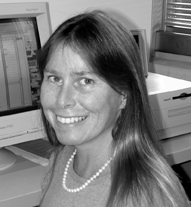REGIONAL GROUPS
by Suzanne Clancy
New England
 |
|
Suzanne
Clancy
|
Mid-October turned out to be a spectacular science week for NESW. First,
a trip to Deer Island on Oct. 14, organized by Ann Parson, gave
members a chance to explore the country's second-largest sewage treatment
facility. Then, on Oct. 17, the group enjoyed an evening with science
journalist and author Richard Preston, best known for his chilling non-fiction
book The Hot Zone. The program, co-sponsored by the MIT Program
in Writing and Humanistic Studies and Whitehead Institute, featured a
talk by the author on how he combines news- and fiction- writing techniques
to add interest and drama in his books and his articles in the New Yorker
magazine. And on Oct. 19, NESW spent an evening with its own Marcia
Bartusiak, who kicked off the tour for her new book, Einstein's
Unfinished Symphony: Listening to the Sounds of Space-Time at the
Harvard-Smithsonian Center for Astrophysics.
In early December, NESW gathered for a special year-end fling at Masa,
a restaurant in the South End whose food has been praised by the Boston
Globe's Alison Arnett for its "southwestern air of sophistication."
Quite possibly Masa has the longest copper bar this side of the Mississippi;
it definitely serves up just about the best margarita in Boston-a "Masarita."
The guest list included science-writer colleagues in town for MIT's Genes
and Cells boot camp.
In early February, David Ropeik of the Harvard School of Public
Health discussed the complexities of communicating risk to the public-everything
from cell phones causing brain cancer to global threats of climate change.
Previously an anchorman at WCVB-TV, in Boston, David is now director
of risk communication at the Harvard Center for Risk Analysis.
Washington, DC
At DCSWA's February program, science writers pondered the public-health
mantra "Early cancer detection saves lives." Translating the
principle of early cancer detection into public health practice can be
a tricky business. What happens when doctors diagnose and treat a cancer
that never would have caused the patient any trouble? This type of overdiagnosis
carries a significant monetary and emotional cost.
Three speakers discussed how best to deploy cancer screening technologies
with the goal of limiting overdiagnosis. Participants were Dr. Barry Kramer
of NIH's Office of Medical Applications of Research; Dr. Bernard Mansheim,
senior vice president and chief medical officer of Coventry Health Care;
and Dr. David Atkins of the Center for Practice and Technology Assessment
at the Agency for Healthcare Research and Quality.
New York
Recent SWINY programs for NASW members and other science writers in the
NYC metro area included a meet-the-book-editors event, the group's annual
holiday party, and a master class on dietary supplements, cosponsored
with the American Chemical Society.
At the book event, authors and editors shared their war stories of how
they conceived, developed, and completed their projects, and discussed
the role of agents. Participants included National Book Critics Circle's
2000 biography award nominee Robin Marantz Henig (The Monk in the Garden),
Dennis Overbye (Einstein in Love), and Carl Zimmer (Parasite
Rex), and editors Laura van Dam (Houghton Mifflin), Rick Kot (Penguin
Putnam), and Stephen Morrow (Freepress, Simon & Schuster).
As part of the ACS's master class "Everything You Wanted to Know
About Dietary Supplements But Are Too Cynical Too Ask," SWINY members
heard presentations by Michael Pariza, Ph.D., director of the Food Research
Institute, University of Wisconsin; Varro Tyler, Ph.D. Sc.D., dean emeritus
of Purdue University School of Pharmacy and Pharmaceutical Sciences; and
Lori Love, M.D. Ph.D., director of Clinical Research and Review Staff
in the Center for Food Safety and Applied Nutrition at the FDA. Pariza
is developing a fatty acid, conjugated linoleic acid, which, in randomized
human studies, appears to help dieters lose fat and build lean muscle.
Tyler specializes in pharmacognosy, the study of pharmacologically active
substances in plants, and is the author of A Guide to Clinically Tested
Herbal Products in the U.S. Market, Health Notes Review 7(4);279-287
(Winter 2000). Love developed a new voluntary surveillance system for
reporting of adverse events associated with special nutritional products,
including infant formulas and dietary supplements.
Georgia
In January, GASWA members visited Emory University's Michael C. Carlos
Museum to see conservation and scientific research on a new collection
of 10 Egyptian mummies acquired in 1999 from Canada's Niagara Falls Museum.
The program began with a tour of the Carlos Museum's conservation laboratory,
where the mummies are being restored.
Members heard Emory radiologist Heidi Hoffman, M.D., describe how she
and radiology colleagues used advanced CT technology to conduct three-dimensional
virtual tours of all 10 mummies. Hoffman shared a "fly-through"
of the mummies that revealed details about mummification methods. Emory
molecular geneticist Jeff Lell, Ph.D. described efforts to use DNA analysis
to help determine whether one of the mummies might be the missing mummy
Rameses I, the only royal mummy remaining outside of Egypt and founder
of the Egyptian Rameside dynasty more than 3,000 years ago. Douglas C.
Wallace, Ph.D., renowned for his research using DNA to trace the earliest
origins of humans, is leading Emory's DNA mummy research.
#
Suzanne Clancy is science writer at The Salk Institute, in La Jolla,
CA. Send information on regional meetings and events to clancy@salk.edu.
|

